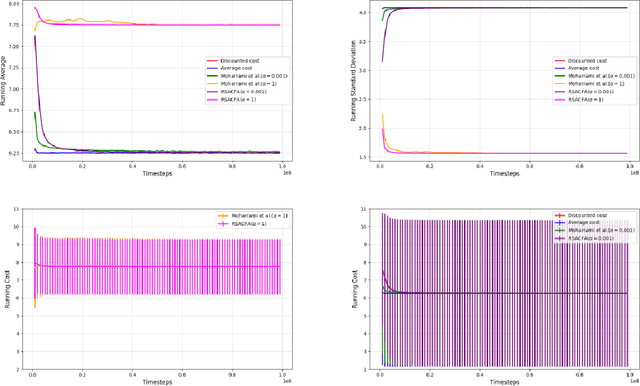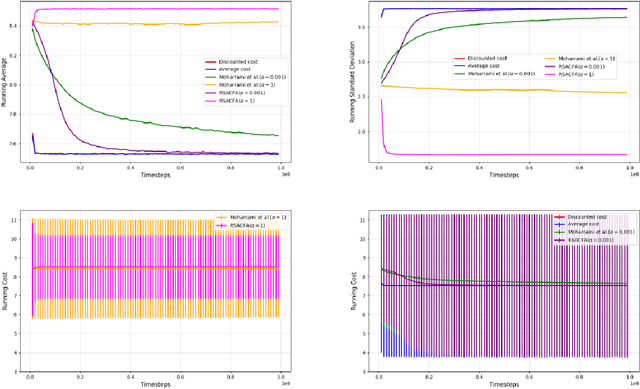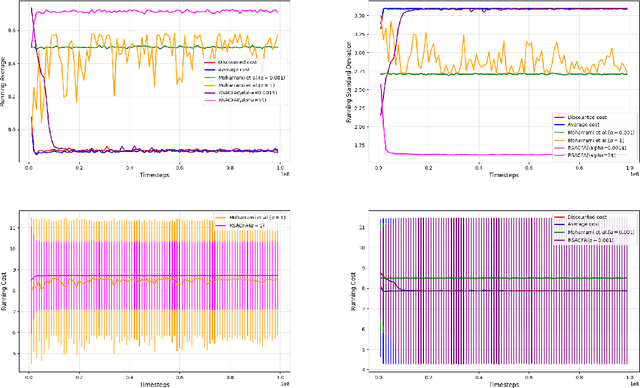Shalabh Bhatnagar
An Actor-Critic Algorithm with Function Approximation for Risk Sensitive Cost Markov Decision Processes
Feb 17, 2025



Abstract:In this paper, we consider the risk-sensitive cost criterion with exponentiated costs for Markov decision processes and develop a model-free policy gradient algorithm in this setting. Unlike additive cost criteria such as average or discounted cost, the risk-sensitive cost criterion is less studied due to the complexity resulting from the multiplicative structure of the resulting Bellman equation. We develop an actor-critic algorithm with function approximation in this setting and provide its asymptotic convergence analysis. We also show the results of numerical experiments that demonstrate the superiority in performance of our algorithm over other recent algorithms in the literature.
Gradient-Weighted Feature Back-Projection: A Fast Alternative to Feature Distillation in 3D Gaussian Splatting
Nov 19, 2024Abstract:We introduce a training-free method for feature field rendering in Gaussian splatting. Our approach back-projects 2D features into pre-trained 3D Gaussians, using a weighted sum based on each Gaussian's influence in the final rendering. While most training-based feature field rendering methods excel at 2D segmentation but perform poorly at 3D segmentation without post-processing, our method achieves high-quality results in both 2D and 3D segmentation. Experimental results demonstrate that our approach is fast, scalable, and offers performance comparable to training-based methods.
Gradient-Driven 3D Segmentation and Affordance Transfer in Gaussian Splatting Using 2D Masks
Sep 18, 2024Abstract:3D Gaussian Splatting has emerged as a powerful 3D scene representation technique, capturing fine details with high efficiency. In this paper, we introduce a novel voting-based method that extends 2D segmentation models to 3D Gaussian splats. Our approach leverages masked gradients, where gradients are filtered by input 2D masks, and these gradients are used as votes to achieve accurate segmentation. As a byproduct, we discovered that inference-time gradients can also be used to prune Gaussians, resulting in up to 21% compression. Additionally, we explore few-shot affordance transfer, allowing annotations from 2D images to be effectively transferred onto 3D Gaussian splats. The robust yet straightforward mathematical formulation underlying this approach makes it a highly effective tool for numerous downstream applications, such as augmented reality (AR), object editing, and robotics. The project code and additional resources are available at https://jojijoseph.github.io/3dgs-segmentation.
Critic-Actor for Average Reward MDPs with Function Approximation: A Finite-Time Analysis
Feb 02, 2024Abstract:In recent years, there has been a lot of research work activity focused on carrying out asymptotic and non-asymptotic convergence analyses for two-timescale actor critic algorithms where the actor updates are performed on a timescale that is slower than that of the critic. In a recent work, the critic-actor algorithm has been presented for the infinite horizon discounted cost setting in the look-up table case where the timescales of the actor and the critic are reversed and asymptotic convergence analysis has been presented. In our work, we present the first critic-actor algorithm with function approximation and in the long-run average reward setting and present the first finite-time (non-asymptotic) analysis of such a scheme. We obtain optimal learning rates and prove that our algorithm achieves a sample complexity of $\mathcal{\tilde{O}}(\epsilon^{-2.08})$ for the mean squared error of the critic to be upper bounded by $\epsilon$ which is better than the one obtained for actor-critic in a similar setting. We also show the results of numerical experiments on three benchmark settings and observe that the critic-actor algorithm competes well with the actor-critic algorithm.
Approximate Linear Programming and Decentralized Policy Improvement in Cooperative Multi-agent Markov Decision Processes
Nov 20, 2023



Abstract:In this work, we consider a `cooperative' multi-agent Markov decision process (MDP) involving m greater than 1 agents, where all agents are aware of the system model. At each decision epoch, all the m agents cooperatively select actions in order to maximize a common long-term objective. Since the number of actions grows exponentially in the number of agents, policy improvement is computationally expensive. Recent works have proposed using decentralized policy improvement in which each agent assumes that the decisions of the other agents are fixed and it improves its decisions unilaterally. Yet, in these works, exact values are computed. In our work, for cooperative multi-agent finite and infinite horizon discounted MDPs, we propose suitable approximate policy iteration algorithms, wherein we use approximate linear programming to compute the approximate value function and use decentralized policy improvement. Thus our algorithms can handle both large number of states as well as multiple agents. We provide theoretical guarantees for our algorithms and also demonstrate the performance of our algorithms on some numerical examples.
Finite Time Analysis of Constrained Actor Critic and Constrained Natural Actor Critic Algorithms
Oct 25, 2023Abstract:Actor Critic methods have found immense applications on a wide range of Reinforcement Learning tasks especially when the state-action space is large. In this paper, we consider actor critic and natural actor critic algorithms with function approximation for constrained Markov decision processes (C-MDP) involving inequality constraints and carry out a non-asymptotic analysis for both of these algorithms in a non-i.i.d (Markovian) setting. We consider the long-run average cost criterion where both the objective and the constraint functions are suitable policy-dependent long-run averages of certain prescribed cost functions. We handle the inequality constraints using the Lagrange multiplier method. We prove that these algorithms are guaranteed to find a first-order stationary point (i.e., $\Vert \nabla L(\theta,\gamma)\Vert_2^2 \leq \epsilon$) of the performance (Lagrange) function $L(\theta,\gamma)$, with a sample complexity of $\mathcal{\tilde{O}}(\epsilon^{-2.5})$ in the case of both Constrained Actor Critic (C-AC) and Constrained Natural Actor Critic (C-NAC) algorithms.We also show the results of experiments on a few different grid world settings and observe good empirical performance using both of these algorithms. In particular, for large grid sizes, Constrained Natural Actor Critic shows slightly better results than Constrained Actor Critic while the latter is slightly better for a small grid size.
The Reinforce Policy Gradient Algorithm Revisited
Oct 08, 2023Abstract:We revisit the Reinforce policy gradient algorithm from the literature. Note that this algorithm typically works with cost returns obtained over random length episodes obtained from either termination upon reaching a goal state (as with episodic tasks) or from instants of visit to a prescribed recurrent state (in the case of continuing tasks). We propose a major enhancement to the basic algorithm. We estimate the policy gradient using a function measurement over a perturbed parameter by appealing to a class of random search approaches. This has advantages in the case of systems with infinite state and action spaces as it relax some of the regularity requirements that would otherwise be needed for proving convergence of the Reinforce algorithm. Nonetheless, we observe that even though we estimate the gradient of the performance objective using the performance objective itself (and not via the sample gradient), the algorithm converges to a neighborhood of a local minimum. We also provide a proof of convergence for this new algorithm.
Off-Policy Average Reward Actor-Critic with Deterministic Policy Search
May 20, 2023Abstract:The average reward criterion is relatively less studied as most existing works in the Reinforcement Learning literature consider the discounted reward criterion. There are few recent works that present on-policy average reward actor-critic algorithms, but average reward off-policy actor-critic is relatively less explored. In this work, we present both on-policy and off-policy deterministic policy gradient theorems for the average reward performance criterion. Using these theorems, we also present an Average Reward Off-Policy Deep Deterministic Policy Gradient (ARO-DDPG) Algorithm. We first show asymptotic convergence analysis using the ODE-based method. Subsequently, we provide a finite time analysis of the resulting stochastic approximation scheme with linear function approximator and obtain an $\epsilon$-optimal stationary policy with a sample complexity of $\Omega(\epsilon^{-2.5})$. We compare the average reward performance of our proposed ARO-DDPG algorithm and observe better empirical performance compared to state-of-the-art on-policy average reward actor-critic algorithms over MuJoCo-based environments.
A Framework for Provably Stable and Consistent Training of Deep Feedforward Networks
May 20, 2023Abstract:We present a novel algorithm for training deep neural networks in supervised (classification and regression) and unsupervised (reinforcement learning) scenarios. This algorithm combines the standard stochastic gradient descent and the gradient clipping method. The output layer is updated using clipped gradients, the rest of the neural network is updated using standard gradients. Updating the output layer using clipped gradient stabilizes it. We show that the remaining layers are automatically stabilized provided the neural network is only composed of squashing (compact range) activations. We also present a novel squashing activation function - it is obtained by modifying a Gaussian Error Linear Unit (GELU) to have compact range - we call it Truncated GELU (tGELU). Unlike other squashing activations, such as sigmoid, the range of tGELU can be explicitly specified. As a consequence, the problem of vanishing gradients that arise due to a small range, e.g., in the case of a sigmoid activation, is eliminated. We prove that a NN composed of squashing activations (tGELU, sigmoid, etc.), when updated using the algorithm presented herein, is numerically stable and has consistent performance (low variance). The theory is supported by extensive experiments. Within reinforcement learning, as a consequence of our study, we show that target networks in Deep Q-Learning can be omitted, greatly speeding up learning and alleviating memory requirements. Cross-entropy based classification algorithms that suffer from high variance issues are more consistent when trained using our framework. One symptom of numerical instability in training is the high variance of the neural network update values. We show, in theory and through experiments, that our algorithm updates have low variance, and the training loss reduces in a smooth manner.
A Cubic-regularized Policy Newton Algorithm for Reinforcement Learning
Apr 21, 2023Abstract:We consider the problem of control in the setting of reinforcement learning (RL), where model information is not available. Policy gradient algorithms are a popular solution approach for this problem and are usually shown to converge to a stationary point of the value function. In this paper, we propose two policy Newton algorithms that incorporate cubic regularization. Both algorithms employ the likelihood ratio method to form estimates of the gradient and Hessian of the value function using sample trajectories. The first algorithm requires an exact solution of the cubic regularized problem in each iteration, while the second algorithm employs an efficient gradient descent-based approximation to the cubic regularized problem. We establish convergence of our proposed algorithms to a second-order stationary point (SOSP) of the value function, which results in the avoidance of traps in the form of saddle points. In particular, the sample complexity of our algorithms to find an $\epsilon$-SOSP is $O(\epsilon^{-3.5})$, which is an improvement over the state-of-the-art sample complexity of $O(\epsilon^{-4.5})$.
 Add to Chrome
Add to Chrome Add to Firefox
Add to Firefox Add to Edge
Add to Edge